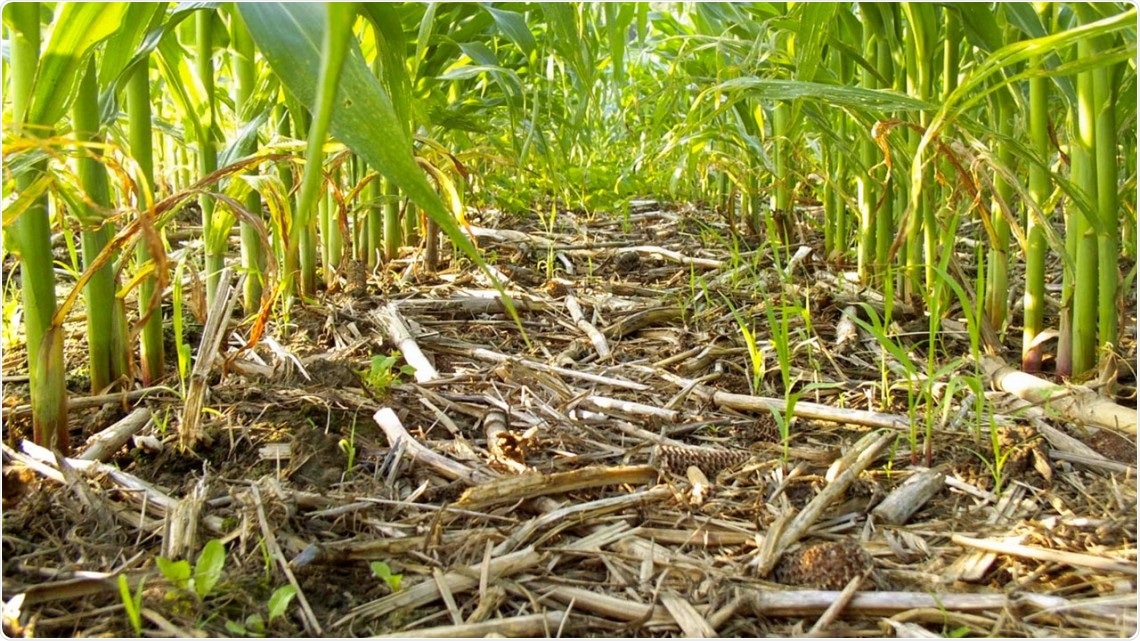Scientists from Cornell recently created an innovative technique to monitor microbes and comprehend the different means through which the microbes process soil carbon. The observations add to the understanding of how bacteria contribute to the global carbon cycle.

Bacteria convert plant biomass, such as this corn organic matter, into soil, which adds to soil fertility and stores carbon in the ground. Image Credit: Image courtesy: Dan Buckley/Provided.
This is a breakthrough finding as soil bacteria are hard to investigate even though they are vital to the health of the biosphere. Soil bacteria transform plant biomass into soil organic matter, the basis for soil fertility and which retains three times more carbon compared to the atmosphere.
By this means, bacteria regulate the amount of carbon ending up in the atmosphere or stored in the soil. Each year soil microbes process around six times more carbon compared to combined anthropogenic emissions.
Enhancing the understanding of the roles played by bacteria in carbon cycling would eventually aid climate modelers to create more precise predictions.
The current research offers evidence on how soil organic matter is formed and lost by disclosing the various strategies microorganisms employ for processing carbon from plants. The study was published on November 19th, 2021, in the Proceedings of the National Academy of Sciences journal.
We want to use this information to study the organisms themselves to get a better understanding of what they are doing and why they are doing it.”
Daniel Buckley, Professor, School of Integrative Plant Science Soil and Crop Sciences Section, College of Agriculture and Life Sciences
Samuel Barnett, a doctoral student in Buckley’s laboratory is the first author of the study.
Buckley states that one of the major uncertainties in computer models that foretell the carbon cycle and climate change is that very little is known about the operating mechanism of soil bacteria and their influence on carbon in the soil.
By understanding what the microbes are doing, we hope to make better predictions about what’s going to happen in the carbon cycle in the future and then make better decisions about how to manage our soil.”
Daniel Buckley, Professor, School of Integrative Plant Science Soil and Crop Sciences Section, College of Agriculture and Life Sciences
Soil microorganisms are small and are difficult to observe in the ground. Hence researchers are not well aware of the need to culture them in the laboratory, which eventually makes them almost impossible to investigate.
In the current research, Buckley and coworkers utilized stable isotopes and high throughput DNA sequencing to pinpoint various species of bacteria and to monitor how each species consumes carbon over time.
This approach allows us to identify the isotopically labeled DNA and figure out which microbe ate each different type of carbon.”
Daniel Buckley, Professor, School of Integrative Plant Science Soil and Crop Sciences Section, College of Agriculture and Life Sciences
He compared the approach to marking dollar bills, releasing them in a city, and later tracking them as they transported through the economy.
The researchers discovered that microorganisms employ various strategies for assimilating carbon. Microorganisms that grow, eat and die quickly feed on plant matter with readily accessible carbon-like sugars. At the same time, other bacteria specialize in carbon that is tougher to break down and absorb.
These microbes grow and take in materials more slowly, specialized, and effective. In the current research, the scientists categorized these kinds of bacteria into guilds—groups of organisms that access food or carbon in the same way.
“The more we understand, the better we can predict what’s happening with carbon in the soil,” stated Buckley.
The researchers further intend to examine if some guilds prefer various habitats, like forests or farm fields, and the impacts of soil pH on microbial communities.
Source:
Journal reference:
Barnett, S. E., et al. (2021) Multisubstrate DNA stable isotope probing reveals guild structure of bacteria that mediate soil carbon cycling. Proceedings of the National Academy of Sciences. doi.org/10.1073/pnas.2115292118.